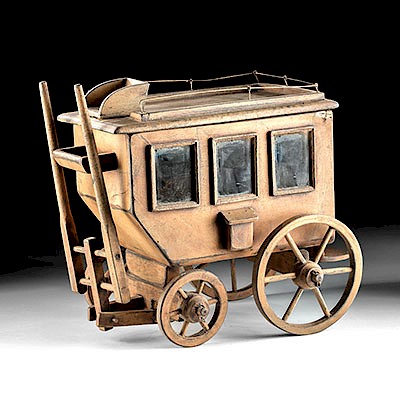Vintage Pacific Islands Tapa Cloth - ca. 1970
Lot 159
About Seller
Artemis Fine Arts
686 S Taylor Ave, Ste 106
Louisville, CO 80027
United States
Selling antiquities, ancient and ethnographic art online since 1993, Artemis Gallery specializes in Classical Antiquities (Egyptian, Greek, Roman, Near Eastern), Asian, Pre-Columbian, African / Tribal / Oceanographic art. Our extensive inventory includes pottery, stone, metal, wood, glass and textil...Read more
Estimate:
$400 - $600
Absentee vs Live bid
Two ways to bid:
- Leave a max absentee bid and the platform will bid on your behalf up to your maximum bid during the live auction.
- Bid live during the auction and your bids will be submitted real-time to the auctioneer.
Bid Increments
| Price | Bid Increment |
|---|---|
| $0 | $25 |
| $300 | $50 |
| $1,000 | $100 |
| $2,000 | $250 |
| $5,000 | $500 |
| $10,000 | $1,000 |
| $20,000 | $2,500 |
| $50,000 | $5,000 |
| $100,000 | $10,000 |
| $200,000 | $20,000 |
About Auction
By Artemis Fine Arts
Nov 14, 2019
Set Reminder
2019-11-14 10:00:00
2019-11-14 10:00:00
America/New_York
Bidsquare
Bidsquare : Ethnographic | Tribal | American Frontier
https://www.bidsquare.com/auctions/artemis-gallery/ethnographic-tribal-american-frontier-4634
Featuring Pre-Columbian, Tribal / Oceanic, Spanish Colonial, historical examples from the Spanish, Mexican, and American frontiers, fossils, and more. All items offered for sale have been legally acquired, are legal to sell and are guaranteed to be as described or your money back. Artemis Fine Arts info@artemisgallery.com
Featuring Pre-Columbian, Tribal / Oceanic, Spanish Colonial, historical examples from the Spanish, Mexican, and American frontiers, fossils, and more. All items offered for sale have been legally acquired, are legal to sell and are guaranteed to be as described or your money back. Artemis Fine Arts info@artemisgallery.com
- Lot Description
Pacific Islands, possibly Fiji, Samoa, Hawaii, Tonga, the Cook Islands, or Papua New Guinea, ca. 1970 CE. A stunning tapa cloth presenting a dramatic contrast between the large solid black area and the border comprised of two bands of stylized geometric motifs in a vibrant color palette of black on natural ground. Tapa cloths are still used today for ceremonial occasions - sometimes made into clothing and masks for dances or offerings for marriages and funerals - as well as impressive wall decorations. This example is vintage and is particularly impressive for its size and beautifully-executed decorative program. Size: 76" W x 33.25" H (193 cm x 84.5 cm)
According to the curatorial staff at Harvard University's Peabody Museum: "For hundreds of years, tapamaking was one of the most sophisticated plant-fiber technologies in the Pacific Islands. In the eighteenth century and before, tapa served as both daily and ceremonial clothing. It was made into headdresses, turbans, loincloths, sashes, girdles, skirts, and ponchos. The cloth was used for bedcovers, wall dividers, or mosquito curtains as well as for special wrappings of staff gods, for the outer layer of sculptures, for wrapping skulls, and for masks. Individuals were surrounded by tapa at birth, weddings, and death. Special cloths were made for dowries, diplomatic gifts, and treaty agreements. Large-scale accumulation of tapa signified wealth and aided in achieving status. It was also used to pay tribute. Barkcloth material, partially processed or as undecorated sheets, was an important trade item and was exchanged for plaited mats, adzes, whaleteeth, and sandalwood. Eventually, the increased availability of woven cotton cloth made in Asia and Europe led to a significant decline of hand-produced tapa, altered its use, and encouraged further changes in the ways in which tapa was decorated." (https://www.peabody.harvard.edu/node/2271)
Provenance: private Poos collection, Overland Park, Kansas, USA; purchased from private collection in 2017 - One of the largest privately held quilt and textile collections in the world, the Poos Collection has evolved over 50 years and through extensive travels to allow for original or point of source acquisition. The collection includes international textiles and garments with an emphasis on West African textiles such as adire, aso oke, kente, and ewe woven prestige cloths as well as Pacific Island textiles like this example.
All items legal to buy/sell under U.S. Statute covering cultural patrimony Code 2600, CHAPTER 14, and are guaranteed to be as described or your money back.
A Certificate of Authenticity will accompany all winning bids.
We ship worldwide and handle all shipping in-house for your convenience.
#145899Multiple old repairs with patches/one area of acid free tape visible on the verso. Expected creases, stains, losses to 2 corners, and a few tears here and there. Still impressive for its age and size.Condition
- Shipping Info
-
All shipping is handled in-house for your convenience. Your invoice from Artemis Gallery will include shipping calculation instructions. If in doubt, please inquire BEFORE bidding for estimated shipping costs for individual items.
-
- Buyer's Premium



 EUR
EUR CAD
CAD AUD
AUD GBP
GBP MXN
MXN HKD
HKD CNY
CNY MYR
MYR SEK
SEK SGD
SGD CHF
CHF THB
THB














